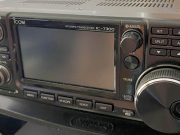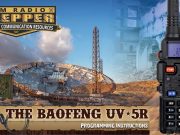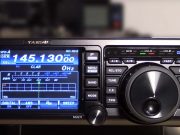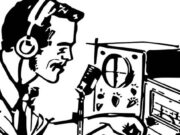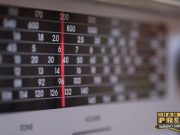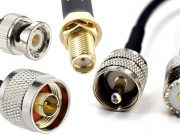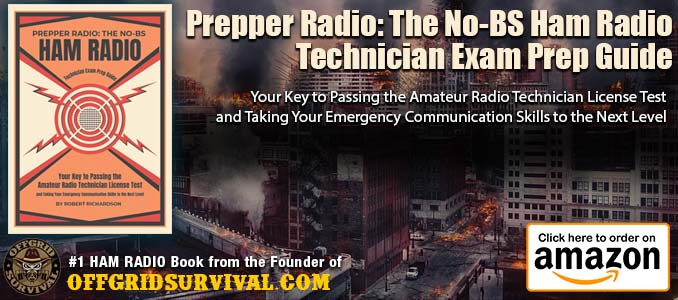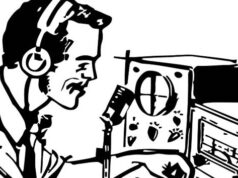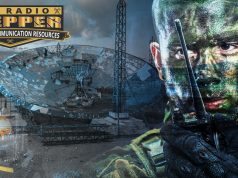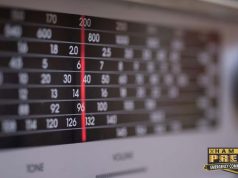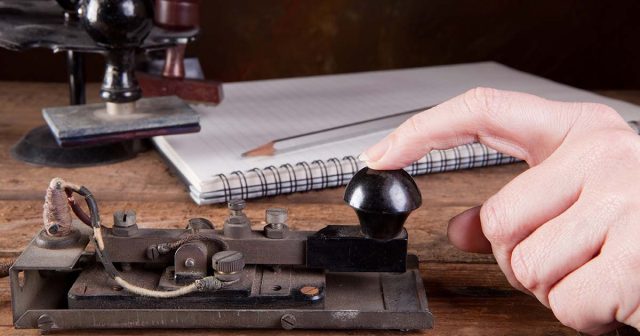
For new Hams or people who monitor radio frequencies, it can sometimes seem like radio operators are speaking another language. To make your journey into Ham Radio a little more enjoyable, we are going to go over some of the most common abbreviations, codes and Phonetics.
Why Do Hams use weird codes and abbreviations?
I know it may seem weird to an outsider, but what we are doing has a purpose and it’s not to hide anything from the outside world.
When it comes to things like Q Codes and abbreviations, much of this comes directly from a time when Hams used Morse Code (CW) to communicate. It helped cut down on the amount of code that needed to be sent, and later it found it’s way into voice communications especially for DXers or contesters who may have a limited time to work a particular station. These codes help us communicate and to pass information as quickly and effectively as possible.
What is the Ham Radio Phonetic Alphabet and why do Hams Use it?
When it comes to using the Phonetic alphabet, the reason isn’t really to make things quicker, but instead to make sure both stations understand what is being said, especially when communicating something like a call sign.
| Letter | Pronunciation | Letter | Pronunciation |
| A | Alpha (AL fah) | N | November (no VEM ber) |
| B | Bravo (BRAH VOH) | O | Oscar (OSS cah) |
| C | Charlie (CHAR lee) | P | Papa (pah PAH) |
| D | Delta (DELL tah) | Q | Quebec (keh BECK) |
| E | Echo (ECK oh) | R | Romeo (ROW me oh) |
| F | Foxtrot (FOKS trot) | S | Sierra (see AIR rah) |
| G | Golf (GOLF) | T | Tango (TANG go) |
| H | Hotel (hoh TELL) | U | Uniform (YOU nee form) |
| I | India (IN dee ah) | V | Victor (VIK tah) |
| J | Juliett (JEW lee ETT) | W | Whiskey (WISS key) |
| K | Kilo (KEY loh) | X | X Ray (ECKS RAY) |
| L | Lima (LEE mah) | Y | Yankee (YANG key) |
| M | Mike (MIKE) | Z | Zulu (ZOO loo) |
What Are Q Codes?
Q-codes are shorthand codes that come from the world of CW. Q-signals or codes are a set of abbreviations for common radio information that can help save time and allow communication between operators who don’t speak a common language. Modern ham radio uses them extensively. The table below lists the most common Q-signals used by hams.
| Code | Question | Answer or Statement |
| QNI | May I join the net? | You may check in… |
| QRA | What is the name (or call sign) of your station? | The name (or call sign) of my station is … |
| QRG | Will you tell me my exact frequency (or that of …)? | Your exact frequency (or that of … ) is … kHz (or MHz). |
| QRH | Does my frequency vary? | Your frequency varies. |
| QRI | How is the tone of my transmission? | The tone of your transmission is (1. Good; 2. Variable; 3. Bad) |
| QRJ | How many voice contacts do you want to make? | I want to make … voice contacts. |
| QRK | What is the readability of my signals (or those of …)? | The readability of your signals (or those of …) is … (1 to 5). |
| QRL | Are you busy? | I am busy. (or I am busy with … ) Please do not interfere. |
| QRM | Do you have interference? [from other stations] | I have interference. |
| QRN | Are you troubled by static? | I am troubled by static. |
| QRO | Shall I increase power? | Increase power. |
| QRP | Shall I decrease power? | Decrease power. |
| QRQ | Shall I send faster? | Send faster (… wpm) |
| QRS | Shall I send more slowly? | Send more slowly (… wpm) |
| QRT | Shall I cease or suspend operation?/ shutoff the radio | I am suspending operation. /shutting off the radio |
| QRU | Have you anything for me? | I have nothing for you. |
| QRV | Are you ready? | I am ready. |
| QRW | Shall I inform … that you are calling him on … kHz (or MHz)? | Please inform … that I am calling him on … kHz (or MHz). |
| QRX | Shall I standby / When will you call me again? | Please standby / I will call you again at … (hours) on … kHz (or MHz) |
| QRZ | Who is calling me? | You are being called by … on … kHz (or MHz) |
| QSA | What is the strength of my signals (or those of … )? | The strength of your signals (or those of …) is … (1 to 5). |
| QSB | Are my signals fading? | Your signals are fading. |
| QSD | Is my keying defective? | Your keying is defective. |
| QSG | Shall I send … telegrams (messages) at a time? | Send … telegrams (messages) at a time. |
| QSK | Can you hear me between your signals? | I can hear you between my signals. |
| QSL | Can you acknowledge receipt? | I am acknowledging receipt. |
| QSM | Shall I repeat the last telegram (message) which I sent you, or some previous telegram (message)? | Repeat the last telegram (message) which you sent me (or telegram(s) (message(s)) numbers(s) …). |
| QSN | Did you hear me (or … (call sign)) on .. kHz (or MHz)? | I did hear you (or … (call sign)) on … kHz (or MHz). |
| QSO | Can you communicate with … direct or by relay? | I can communicate with … direct (or by relay through …). |
| QSP | Will you relay a message to …? | I will relay a message to … . |
| QSR | Do you want me to repeat my call? | Please repeat your call; I did not hear you. |
| QSS | What working frequency will you use? | I will use the working frequency … kHz (or MHz). |
| QST | Should I repeat the prior message to all amateurs I contact? | Here follows a broadcast message to all amateurs. |
| QSU | Shall I send or reply on this frequency (or on … kHz (or MHz))? | Send or reply on this frequency (or on … kHz (or MHz)). |
| QSW | Will you send on this frequency (or on … kHz (or MHz))? | I am going to send on this frequency (or on … kHz (or MHz)). |
| QSX | Will you listen to … (call sign(s) on … kHz (or MHz))? | I am listening to … (call sign(s) on … kHz (or MHz)) |
| QSY | Shall I change to transmission on another frequency? | Change to transmission on another frequency (or on … kHz (or MHz)). |
| QSZ | Shall I send each word or group more than once? | Send each word or group twice (or … times). |
| QTA | Shall I cancel telegram (message) No. … as if it had not been sent? | Cancel telegram (message) No. … as if it had not been sent. |
| QTC | How many telegrams (messages) have you to send? | I have … telegrams (messages) for you (or for …). |
| QTH | What is your position in latitude and longitude (or according to any other indication)? | My position is … latitude…longitude |
| QTR | What is the correct time? | The correct time is … hours |
| QTU | At what times are you operating? | I am operating from … to … hours. |
| QTX | Will you keep your station open for further communication with me until further notice (or until … hours)? | I will keep my station open for further communication with you until further notice (or until … hours). |
| QUA | Have you news of … (call sign)? | Here is news of … (call sign). |
| QUC | What is the number (or other indication) of the last message you received from me (or from … (call sign))? | The number (or other indication) of the last message I received from you (or from … (call sign)) is … |
| QUD | Have you received the urgency signal sent by … (call sign of mobile station)? | I have received the urgency signal sent by … (call sign of mobile station) at … hours. |
| QUE | Can you speak in … (language), – with interpreter if necessary; if so, on what frequencies? | I can speak in … (language) on … kHz (or MHz). |
| QUF | Have you received the distress signal sent by … (call sign of mobile station)? | I have received the distress signal sent by … (call sign of mobile station) at … hours. |
Morse Code Cheat Sheet
When it comes to using something like Morse Code (CW), some of us enjoy it, but from an emergency communications perspective, it’s an extremely efficient way to pass information without a lot of power or gear.

ARRL Communications Procedures
| Voice | Code | Situation |
| Go ahead | K | Used after calling CQ, or at the end of a transmission, to indicate any station is invited to transmit. |
| Over | AR | Used after a call to a specific station, before the contact has been established. |
| KN | Used at the end of any transmission when only the specific station contacted is invited to answer. | |
| Stand by or wait | AS | A temporary interruption of the contact. |
| Roger | R | Indicates a transmission has been received correctly and in full. |
| Clear | SK | End of contact. SK is sent before the final identification. |
| Leaving the air or closing the station | CL | It indicates that a station is going off the air, and will not listen or answer any further calls. CL is sent after the final identification. |
The RST System
Readability
- 1–Unreadable
- 2–Barely readable, occasional words distinguishable.
- 3–Readable with considerable difficulty.
- 4–Readable with practically no difficulty.
- 5–Perfectly readable.
Signal Strength
- 1–Faint signals, barely perceptible.
- 2–Very weak signals.
- 3–Weak signals.
- 4–Fair signals.
- 5–Fairly good signals.
- 6–Good signals.
- 7–Moderately strong signals.
- 8–Strong signals.
- 9–Extremely strong signals.
Tone
- 1–Sixty cycle a.c or less, very rough and broad.
- 2–Very rough a.c., very harsh and broad.
- 3–Rough a.c. tone, rectified but not filtered.
- 4–Rough note, some trace of filtering.
- 5–Filtered rectified a.c. but strongly ripple-modulated.
- 6–Filtered tone, definite trace of ripple modulation.
- 7–Near pure tone, trace of ripple modulation.
- 8–Near perfect tone, slight trace of modulation.
- 9–Perfect tone, no trace of ripple or modulation of any kind.
Master List of Amateur Radio Terms and Abbreviations:
A/D – Analog-to-Digital
antenna tuner – Impedance-matching device that matches the antenna system input impedance to the transmitter, receiver, or transceiver output impedance.
AM – Amplitude Modulation See URL: Modulation Modes
AMSAT – Radio Amateur Satellite Corporation
AMTOR – Amateur Teleprinter Over Radio, a version of RTTY
antenna – a device that intercepts or radiates radio frequency energy
antenna tuner – device that matches the antenna impedance to the receiver or transceiver output impedance
APRS – Automatic Packet Position Reporting System – See URL: APRS
ARA – Amateur Radio Association
ARC – Amateur Radio Club. Military Designation for Avionics (Aviation Radio Composite)
ARES – Amateur Radio Emergency Service
ARRL – American Radio Relay League
balanced line -A feed line with two conductors having equal but opposite voltages, with neither conductor at ground potential
balun – balance to unbalance, a device used to couple a balanced antenna to an unbalanced feed line
band – a range of frequencies allotted for a particular use
barefoot – transmitting with a transceiver alone and no linear amplifier
beacon – A station that transmits one-way signals for the purpose of navigation, homing, and propagation condition determination
BFO – Beat frequency oscillator. Used to mix with the incoming signal to produce an audio tone for CW reception
BNC – Coax connector commonly used with VHF/UHF equipment
BPL – BroadBand Over Power Lines
bps – Bits per second
BPSK – Binary Phase Shift Keying, digital DSB suppressed carrier modulation
boat anchor – antique ham equipment
calling frequency – A standard frequency where stations attempt to contact each other
capacitor – an electronic component composed of two or more conductive plates separated by an insulating material. A capacitor stores energy in an electric field
carrier – a pure continuous radio emission at a fixed frequency, without modulation
CC&R’s – Covenents, Conditions, and Restrictions
chassis ground – the common connection for all parts of a circuit that connect to the negative side of the power supply
coax – A type of wire that consists of a center wire surrounded by insulation and a grounded shield
code – usually refers to Morse code, but used for others such as baudot
coil – a conductor wound into a series of loops
color code – Colored stripes painted on the body of resistors and other components to show value
condenser – old term for capacitor composed of two or more conductive plates separated by an insulating material to store energy in an electric field
control operator – the Amateur Radio operator designated to “control” the operation of the repeater, as required by FCC regulations
core – the material used in the center of an inductor coil, where magnetic fields is concentrated
CQ – calling any amateur radio station, may be sent in CW, phone or some digital modes
CSCE – Certificate of Successful Completion of Examination (U.S.) issued when amateur radio license examinations passed
CTCSS – abbreviation for continuous tone-controlled squelch system
current – a flow of electrons in an electrical circuit
CW – Continuous Wave, an unmodulated, uninterrupted RF wave used with Morse code
dB – Decibel (1/10 of a Bel); unit for the ratio of two power measurements
de – Morse code for “from” e.g., AC6V de WA0PPP
diplexer – A frequency splitting and isolation device to couple two transceivers to a single or dual band antenna
dipole – the basic wavelength antenna consisting of a length of wire or tubing, open and fed at the center
downlink – Channel used for satellite-to-earth communications
DPSK – Differential Phase Shift Keying, a form of BPSK
DSP – Digital Signal Processing – allows for filtering, noise reduction, audio equalization, etc.
DTMF – abbreviation for dual-tone multi-frequency, the series of tones generated from a keypad
dual-band antenna – antenna designed for use on two different Amateur Radio bands
dummy load – a device which substitutes for an antenna during tests
duplex – mode in which a radio transmits on one frequency and receives on another
duplexer – device which allows a single antenna to transmit and receive simultaneously
DVM – Digital voltmeter
DX – a distant station or to contact a distant station
DXCC – award for contacting and confirming 100 or more different countries
dynamic range – How well a receiver can handle strong signals with overloading; any measure of over 100 decibels is considered excellent
earth ground – a circuit connection to a ground rod driven into the earth
elmer – a mentor; an experienced operator who tutors newer operators
eleven meters – currently the CB band, once a Ham band
EME – Earth-Moon-Earth; using the moon as a reflector for a signal path; moonbounce
EMF – Electromotive force; voltage
EMI – Electromagnetic interference
emission mode – the form of a radio emission, such as AM, FM, or single sideband
ERP – Effective Radiated Power
ether – Old theory for the medium once believed to conduct radio waves
Eu – Europe
FCC – Federal Communications Commission, US governmental body that regulates the radio spectrum
feedline – wire or cable connecting a radio to an antenna
FET – Field-effect transistor
field day – Amateur Radio activity in June to practice emergency communications
field strength meter – a test instrument used to show the presence and strength of RF energy
filter – A circuit or device that will allow certain frequencies to pass while rejecting others
final – The last transmission by a station during a contact. Also the last amplifying stage of a radio transmitter
FM– Frequency Modulation
fox hunt – a contest to locate a hidden transmitter
frequency – the rate of oscillation – audio and radio wave frequencies are measured in Hertz
FSK – Frequency-shift keying
full-break in (QSK) – allows a station to break into the communication without waiting for the transmitting station to finish
full duplex – a communications mode in which a radios can transmit and receive at the same time by using two different frequencies
gain, antenna – increase in effective power radiated or receiveed by an antenna in a certain desired direction
GHz – gigahertz – billion (1,000,000,000) hertz
gray line – a band around the Earth that separates daylight from darkness
green stamp – U.S. dollar bill sent along with a QSL card
ground – Common zero-voltage reference point
ground-plane antenna – a quarter-wavelength vertical antenna with several radials extending horizontally from the base
ground wave propagation – radio waves that travel along the surface of the earth, even beyond the horizon.
half duplex – mode in which a radio transmits and receives on two different frequencies but performs only one of these operations at any given time
half-wave dipole – basic wavelength antenna consisting of a length of wire or tubing, open and fed at the center
hand-held – portable transceiver small enough to be carried easily
hamfest – event at which hams meet to buy, sell, and swap equipment
Hertz – the standard unit used to measure frequency (one Hertz equals one complete cycle per second)
HF – High Frequency – 3 MHz to 30 MHz
hi hi – ha ha (laughter) the Morse equivalent of a laugh
high-pass filter – a filter designed to pass high frequency signals, while blocking lower frequency signals
Hiram Percy Maxim – AKA “The Old Man” 1AW, ARRL founder. See also:
homebrew – term for home-built, noncommercial radio equipment
horizontally polarized wave – an electromagnetic wave with its electric lines of force parallel to the ground
HSMM– High Speed Multi Media. An ARRL working group and individual Amateur effort as well. Primary to High speed Voice, Video, and Data transmission on the Amateur allocations within the 2.4GHZ and 5.8GHz bands using commonly available WiFi equipment with High Gain Directional Antennas. Often referred to as the “hinternet” hinternet- Slang term often used in reference to HSMM.
HT – Handheld Transceiver, also known as a Handy-Talkie or Walkie-Talkie. A radio small enough to be held in your hand. Typically used with radios that operate on the VHF ham bands or above.
IF – Intermediate Frequency — Intermediate frequency, resultant frequency from heterodyning the carrier frequency with an oscillator, mixing incoming signals to an intermediate frequency enhances amplification, filtering and the processing signals
image – A false signal produced in a superheterdyne receivers circuitry
impedance – opposition to the flow of electric current and radio energy measured in ohms
inductance – a measure of the ability of a coil to store energy in a magnetic field
inductor – a component composed of a coil of wire wound on a central core that stores energy in a magnetic field
input frequency – the frequency of the repeater’s receiver (and your transceiver’s transmitter)
I/O – Input/Output
ionosphere – electrically charged region of the atmosphere 40 to 400 miles above the surface that refracts radio signals
IRC – International Reply Coupon, used for pre-paid postage to foreign locations IRC
IRLP – Radio Linking Project using VoIP
isotropic – theoretical “Single Point” antenna used calculate gain
ITU – International Telecommunications Union, the body which specifies worldwide guidelines for use of electromagnetic spectrum for communications purposes
J antenna (J pole) – a mechanically modified version of the zepp (zeppelin) antenna
K- index – A measure of the Earths magnetic field as measured at Boulder, Colorado
keyer – device for sending Morse Code semi-automatically
kilocycles – thousand cycles per second, replaced by kiloHertz (kHz)
kilohertz – one thousand hertz (see “hertz”)
ladder line — open wire transmission (antenna) line
landline — ham slang for telephone lines
LCD – Liquid Crystal Display
LED – Light-emitting diode
LF – Low Frequency – 30 kHz to 300 kHz
lid – a poor operator, one who does not follow proper procedures or sends sloppy morse code
linear – an amplifier used after the transceiver output named for its purity of amplification
line-of-sight propagation – term used to describe straight line propagation
LSB – Lower Side Band
LW – Long Wave 150 – 300 KHz
magnetic mount or mag-mount – antenna with a magnetic base
mA/h – milliampere per hour
MARS – Military Affiliate Radio System
MCW – Modulated Continuous Wave, a fixed audio tone modulates a carrier
megacycles – million cycles per second
megahertz MHZ – million hertz (see Hertz)
meteor scatter – ionized trails of meteors used as a reflecting media
MF – Medium Frequency – (300-3,000 kHz)
mic (mike) – microphone
microwave – the region of the radio spectrum above 1 gigahertz (GHz)
mW – milliwatt (1/1,000 watt)
mobile – an amateur radio station installed in a vehicle
mode – (see emission mode)
modulate – create a radio emission so that it contains information (voice, Morse code, music, binary)
MUF – Maximum Usable Frequency, the highest frequency that will support transmissions off of the ionosphere
mV – millivolt (1/1,000 volt)
MW – Medium Wave – 300 – 3000 kHz
NCS – Net Control Station
net – A group of stations that meet on a specified frequency at a certain time
NiCad – Nickel Cadmium, generally refers to a type of rechargeable battery
NiMH – Nickel Metal Hydride, generally refers to a newer type of rechargeable battery
NIST– National Institute of Standards and Technology. US Government Standards Body for Time, Frequency, Measures, Weights. Formerly known as The National Bureau of Standards
NODE – A remotely controlled TNC/digipeater – used as a connect point in packet radio
NPN – A type of transistor that has a layer of P-type semiconductor material sandwiched between layers of N-type semiconductor material
OFDM– Orthogonal Frequency – Division Multiplexing. Common modulation type used in HSMM work.
Ohm – The fundamental unit of resistance offered when a potential of one Volt results in a current of one Ampere
OM – friendship term, friend, pal or buddy
open repeater – (Repeater Term) a repeater whose access is not limited
OSCAR – Orbiting Satellite Carrying Amateur Radio
oscillate – vibrate, generate an AC or other periodic signal
oscilloscope – an electronic test instrument used to observe wave forms and voltages on a cathode-ray tube. Displays time on the X-axis and amplitude on the Y-axis, Z-axis is intensity of the CRT spot
packet radio – a system of digital communication whereby information is transmitted in short bursts
paddle – Morse code key
PC – Printed Circuit
PCM – pulse code modulation based on the Shannon’s communication theory
PEP – Peak envelope power – the average power of a signal at its largest amplitude peak
peak-inverse-voltage (PIV) – the maximum voltage a diode can withstand when it is reverse biased (not conducting)
phase – the time interval between one event and another in a regularly recurring cycle
phase modulation – varying the phase of an RF carrier in response to the instantaneous changes in an audio signal
phone – voice modulation
phone patch – A connection between a two-way radio unit and the public telephone system
picket fencing – condition experienced on VHF and above where a signal rapidly fluctuates in amplitude causing a sound akin to rubbing a stick on a picket fence
pico – the metric prefix for 10^-12, or divide by 1,000,000,000,000
pileup – multiple stations calling a DX or contest station
pirate – Station using an existing callsign and illegally operating on the air
PL – Private Line with repeaters, same as CTCSS– low frequency audio tones used to alert or control receiving stations
PLL– Phase-lock loop
PM – Phase Modulation, similar to Frequency Modulation
PNP – a type of transistor that has a layer of N-type semiconductor sandwiched between layers of P-type semiconductor material
propagation – the means or path by which a radio signal travels from a transmitting station to a receiving station
PSK31 – A digital transmission mode — Phase Shift keying with 31.25 baud rate – See PSK31
PTT – Push To Talk, the switch in a transmitter circuit that activates the microphone circuitry
Q-signals or Q Codes – a set of three-letter codes which are used by amateurs as abbreviations – See Above for list of Q Codes
QSL Manager – A person, usually an Amateur Radio operator, who manages the receiving and sending of QSL cards for a managed station)
RAC – Radio Amateurs of Canada, a national amateur radio organization in Canada – See leagues
RACES – Radio Amateur Civil Emergency Service
ragchewing – chatting informally via radio
RDF – Radio Direction Finding
reactance – opposition to current that a capacitor or inductor creates in an AC circuit
reading the mail – to listen to a QSO without participating
repeater – a receiver/transmitter that listens for transmission and re-transmits them
resonance – condition where Xc = XL, establishing a resonant circuit – used for selectivity (parallel circuit) or a maximum impedance circuit (series)
Rettysnitch – See definition of Wouff-Hong
RF – Radio Frequency, emissions in the radio portion of the electromagnetic spectrum
RFI – Radio Frequency Interference
rig – a radio (transmitter, receiver, or transceiver)
RIT – Receiver incremental tuning. Also known as a Clarifier
RMS – Root mean square
roger — I understand – Received 100% In CW: “R”
rotor – (see “rotator”)
rotator – a device attached to an antenna mast which rotates it
Rover – A station that operates from several grid squares or counties during a contest
RST – “Readability, Signal, and Tone”, a three-digit report indicating how well an operator’s emissions are being received
RTTY – radio teletype – A form of digital communications
SASE – Self-addressed, stamped envelope
selectivity – Ability of a receiver to reject signals adjacent to tuned signal
sensitivity – A receivers ability to receive weak signals
separation or split the difference (in kHz) between a repeater’s transmitter and receiver frequencies
series circuit – an electrical circuit in which all the electrons must flow through every part of the circuit
shack – Ham station operating area
SHF – Super High Frequency 3 – 30 GHz
short path — in degrees – the direct great signal bearing path between two locations. Long path is the reciprocal bearing
signal – a radio emission
silent key – a deceased amateur operator
simplex – a communications mode in which a radio transmits and receives on the same frequency
SITOR-A – Simplex teleprinting over radio system, mode A
SITOR-B – Simplex teleprinting over radio system, mode B (FEC mode)
SK – Silent Key, an amateur term for indicating that a ham has passed away. Also one of the prosigns — meaning “end of contact”
skip zone – dead zone, too far for ground wave propagation and too near for sky wave propagation
skyhook – antenna
sky wave propagation – the transmitting of radio waves which reflect off of the ionosphere
S-Meter – Signal Strength Meter
S/N – Signal-to-noise ratio
speech processor – A circuit that increases the average level of the modulating signal applied to a transmitter
splatter – a type of interference to stations on nearby frequencies
split – DX stations often operate split – that is transmitting on one frequency and listening at a different frequency
SQL – Squelch – A circuit that mutes the receiver when no signal is present, thereby eliminating band noise
squelch tail – (Repeater Term) A brief bit of noise heard between the end of a radio transmission and the reactivation of the receivers squelch circuit
SSB – Single Side Band
SSTV – Slow Scan Television
straight key – a non-electronic Morse code key with one paddle
superheterodyne – a radio receiver scheme which beats or heterodynes a second radio frequency to the incoming radio signals. The combined frequencies form an intermediate (IF) third frequency
SW – Short Wave
SWL – Short Wave Listening
SWR – Standing Wave Ratio, a measure of how much radio energy sent into an antenna system is being reflected back to the transmitter
SWR meter – a device used to determine the Standing Wave Ratio of an antenna system
telegraphy – the transmission of information in Morse code format
telephony – the transmission of information in voice format
third-party communications – messages passed from one amateur to another on behalf of a third person
TI – Talk-In Frequency
ticket – slang for an amateur radio license
tone pad – an array of 12 or 16 numbered keys that generate the standard telephone dual tones
TOR – Telex over radio
TNC – Terminal Node Controller, a device which interfaces a computer to a transceiver and performs a function similar to a modem
TNC – Threaded Niell-Concelman (standard connector type used on Coax cable, named for its inventors)
top band — 160 Meter Ham Band (highest number meter band)
traffic – a message or messages sent by radio
transceiver – a radio that both transmits and receives
twisted pair – ham slang for telephone or telephone lines
two-tone test – A method of testing a side-band transmitter
UHF – Ultra High Frequency 300 – 3000 MHz
Uncle Charlie – The FCC
uplink – Channel used for earth-to-satellite communications
USB – Upper Side Band common for the 20, 17, 15, 12, and 10 meter HF amateur bands, VHF and UHF bands
UTC – Coordinated Universal Time
utility stations – Stations other than broadcast, or amateur stations not intended to be heard by the public including aviation, radiotelephone, marine, embassy, and military
VA – Volt Amperes – measure of apparent power
VAC – Volts Alternating Current
varactor diode – a component whose capacitance varies as the reverse bias voltage is changed
VCO – Voltage-controller oscillator
VEC – Volunteer Examiner Coordinator, an amateur radio organization empowered by the FCC to recruit, organize, regulate and coordinate Volunteer Examiners
VFO – Variable Frequency Oscillator
VHF – Very High Frequency 30 – 300 MHz
VLF – Very Low Frequency 3 – 30 KHz
VMOS – Vertical metal-oxide semiconductor
VOA – Voice Of America.
VOM – Volt-ohm-meter
VOX – Voice Operated Transmit
VSWR – Voltage standing wave ratio
VTVM – Vacuum tube voltmeter
VXO – Variable crystal oscillator
W1AW– Official ARRL station callsign, also transmits Amateur Radio News Bulletins, Propagation Conditions and Forecasts, and Morse Code Practice. Former Call of Hiram Percy Maxim, ARRL founder.
WAC – Worked All Continents award from the IARU, administered by ARRL
wallpaper – QSL cards, awards, special event certificates
WARC – World Administrative Radio Conference
WARC Bands – An expression to indicate the bands allocated in 1979 — 17M, 12M and 30M
WAS – Worked All States award from ARRL
WAZ – Worked All Zones award from CQ magazine for confirmed contact with each of 40 zones
WEFAX – Weather facsimile, reconstructed satellite images and photographs
wireless – radio (As opposed to wired – telegraph)
WIRES – (Wide-coverage Internet Repeater Enhancement System) is an Internet communication system which expands the range of amateur radio communication. WIRES-X – an amateur node station connecting to the Internet is used as the access point and connects the wireless communication to the Internet.
WPM – Words per minute; as in Morse code or typing speed
WWV – National Bureau of Standards radio station (time signals)
WWVB – NIST radio station (broadcasts time signals)
WX – weather
XCVR– Transceiver
XFMR – Transformer
XTAL – Crystal
XYL – Ex-Young Lady, wife
Yagi – “beam” directional antenna array
zero beat – Adjust the frequencies of two signals so that they are exactly equal and in phase
Zepp antenna – simply a weighted wire reeled down and up from early lighter-than-Zeppelin air-ships
Zulu – Coordinated Universal Time. Also the phonetic for the letter Z
NUMBERS 0-9
73 – Best regards
88 – Love and kisses

 <
<

